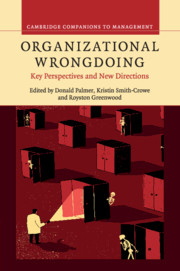Book contents
- Frontmatter
- Contents
- List of figures
- List of tables
- List of contributors
- Foreword
- 1 The imbalances and limitations of theory and research on organizational wrongdoing
- 2 On taking the theoretical substance of outcomes seriously: a meta-conversation
- 3 Wrong paths to right: defining morality with or without a clear red line
- 4 From market enablers to market participants: redefining organizational and political-legal arrangements and opportunities for financial wrongdoing,1930s–2000
- 5 Wrongdoing and market development: an examination of the distinct roles of trust and distrust
- 6 Bad apples, bad barrels and bad cellars: a “boundaries” perspective on professional misconduct
- 7 S/he blinded me with science: the sociology of scientific misconduct
- 8 Social networks and organizational wrongdoing in context
- 9 Falling stars: celebrity, infamy, and the fall from (and return to) grace
- 10 Compensation and employee misconduct: the inseparability of productive and counterproductive behavior in firms
- 11 Beware of organizational saints: how a moral self-concept may foster immoral behavior
- 12 “Is it me? Or is it me?” The role of coactivated multiple identities and identifications in promoting or discouraging workplace crimes
- 13 Consequences of organizational misconduct: too much and too little punishment
- 14 Who bears the brunt? A review and research agenda for the consequences of organizational wrongdoing for individuals
- 15 Organizational wrongdoing and media bias
- 16 Ethical learning: releasing the moral unicorn
- Index
- References
1 - The imbalances and limitations of theory and research on organizational wrongdoing
Published online by Cambridge University Press: 05 July 2016
- Frontmatter
- Contents
- List of figures
- List of tables
- List of contributors
- Foreword
- 1 The imbalances and limitations of theory and research on organizational wrongdoing
- 2 On taking the theoretical substance of outcomes seriously: a meta-conversation
- 3 Wrong paths to right: defining morality with or without a clear red line
- 4 From market enablers to market participants: redefining organizational and political-legal arrangements and opportunities for financial wrongdoing,1930s–2000
- 5 Wrongdoing and market development: an examination of the distinct roles of trust and distrust
- 6 Bad apples, bad barrels and bad cellars: a “boundaries” perspective on professional misconduct
- 7 S/he blinded me with science: the sociology of scientific misconduct
- 8 Social networks and organizational wrongdoing in context
- 9 Falling stars: celebrity, infamy, and the fall from (and return to) grace
- 10 Compensation and employee misconduct: the inseparability of productive and counterproductive behavior in firms
- 11 Beware of organizational saints: how a moral self-concept may foster immoral behavior
- 12 “Is it me? Or is it me?” The role of coactivated multiple identities and identifications in promoting or discouraging workplace crimes
- 13 Consequences of organizational misconduct: too much and too little punishment
- 14 Who bears the brunt? A review and research agenda for the consequences of organizational wrongdoing for individuals
- 15 Organizational wrongdoing and media bias
- 16 Ethical learning: releasing the moral unicorn
- Index
- References
Summary
This volume is devoted to exploring the causes, processes, consequences, and nature of wrongdoing in and by organizations. Such conduct, hereafter for convenience referred to as organizational misconduct and organizational wrongdoing, includes a wide range of behaviors – violations of criminal, civil, and administrative law; transgressions of explicit industry and professional codes; and contraventions of less codified organizational rules, social norms, and ethical principles. Given their apparent greater incidence and scale in recent years, it is not surprising that these behaviors have received increasing attention in scholarly circles, in practitioner communities, and among the general public as of late. Moreover, and contrary to previous work, recent scholarship has adopted a range of perspectives and elaborated its focus and concerns to include aspects of wrongdoing previously ignored. This introduction outlines how recent scholarship contributes to the renaissance of management scholarship on organizational misconduct.
The dearth of theory and research on organizational wrongdoing
Kenneth Boulding (1958), in his review of the first two volumes of Administrative Science Quarterly, identified the study of misconduct in and by organizations as an object of inquiry that was of enduring importance to management practitioners and society but that was receiving scant attention from the journal's contributors. Since Boulding's early assessment, other observers have periodically lamented management scholars’ neglect of organizational misconduct relative to other topics of apparently greater interest, such as organizational efficiency and effectiveness (Brief 2000; Hinings and Greenwood 1982). This lack of attention to misconduct in and by organizations implicitly conveys the assumption that organizational wrongdoing is rare and peripheral to organizational functioning.
At the dawn of the new century, though, a series of episodes of organizational wrongdoing received massive media attention, including incidents at Enron, Arthur Andersen, Tyco, and WorldCom in the United States, Barclays Bank in the United Kingdom, Parmalat in Italy, Satyam in India, as well as incidents of misconduct at a large number of multi-national financial institutions implicated in the recent global financial crisis and in international governance organizations such as the world soccer Fédération Internationale de Football Association (FIFA). These affairs likely received extensive media attention partly because new forms of media (most importantly, forms of media made possible by the expansion of the Internet) were emerging that facilitated the dissemination and amplification of news about misconduct.
- Type
- Chapter
- Information
- Organizational WrongdoingKey Perspectives and New Directions, pp. 1 - 16Publisher: Cambridge University PressPrint publication year: 2016
References
- 4
- Cited by



